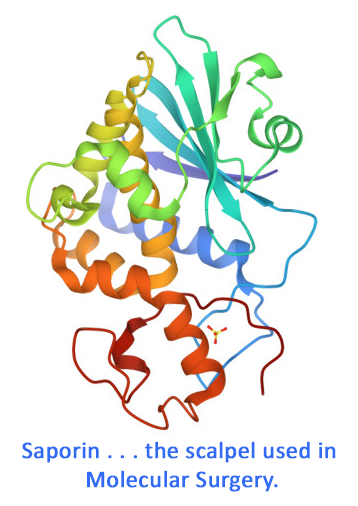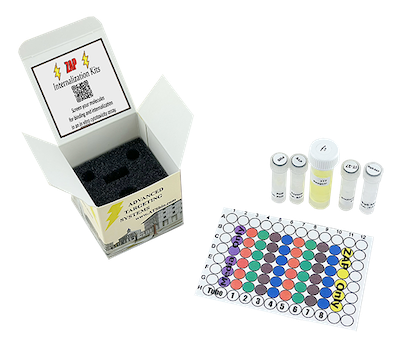Streptavidin-ZAP is a chemical conjugate of streptavidin and the ribosome-inactivating protein, saporin. It converts biotinylated materials into targeted toxins. This kit converts biotinylated materials into targeted toxins and will allow you to evaluate the ability of your reagent to internalize upon binding to its receptor. It is the perfect tool to screen your biotinylated antibody in vitro.
This kit includes Streptavidin-ZAP (IT-27) and BIgG-SAP control conjugate for your primary antibody host species and Saporin (PR-01) plus reagents for developing a cytotoxicity assay (PMS, XTT).
ATS recommends using a species-specific ZAP Antibody Internalization Kit when possible. View available kits here.
Other ZAP Conjugates:
Need another ZAP Conjugate for your target? Check here for other species & targets including in vivo and in vitro options.
keywords: Streptavidin, Avidin, Biotin, screening, ADC, Antibody Drug Conjugate, saporin, streptavidinylated, Streptavidin-SAP, Streptavidin-ZAP, Strep-ZAP, Strep-SAP, Biotin-Z, in vitro
Streptavidin-saporin: Converting biotinylated materials into targeted toxins
Ancheta LR, Shramm PA, Bouajram R, Higgins D, Lappi DA (2023) Streptavidin-saporin: Converting biotinylated materials into targeted toxins. Toxins 15(3):181. doi: 10.3390/toxins15030181 PMID: 36977072
Summary: This manuscript describes the myriad of ways Streptavidin-ZAP is used and how this technology supports the scientific process of ‘Molecular Surgery’ and progress in research and drug development. Insights from publications and research performed using Streptavidin-ZAP and its impact on academia and industry for research and drug development are presented.
Related Products: Streptavidin-ZAP (Cat. #IT-27)
Read the full article.
Saporin as a commercial reagent: its uses and unexpected impacts in the biological sciences-tools from the plant kingdom
Ancheta LR, Shramm PA, Bouajram R, Higgins D, Lappi DA (2022) Saporin as a commercial reagent: its uses and unexpected impacts in the biological sciences-tools from the plant kingdom. Toxins (Basel) 14(3):184. doi: 10.3390/toxins14030184 PMID: 35324681
Summary: Saporin is a ribosome-inactivating protein that can cause inhibition of protein synthesis and causes cell death when delivered inside a cell. Development of commercial Saporin results in a technology termed ‘molecular surgery’, with Saporin as the scalpel. Its low toxicity (it has no efficient method of cell entry) and sturdy structure make Saporin a safe and simple molecule for many purposes. The most popular applications use experimental molecules that deliver Saporin via an add-on targeting molecule. These add-ons come in several forms: peptides, protein ligands, antibodies, even DNA fragments that mimic cell-binding ligands. Cells that do not express the targeted cell surface marker will not be affected. This review will highlight some newer efforts and discuss significant and unexpected impacts on science that molecular surgery has yielded over the last almost four decades. There are remarkable changes in fields such as the Neurosciences with models for Alzheimer’s Disease and epilepsy, and game-changing effects in the study of pain and itch. Many other uses are also discussed to record the wide-reaching impact of Saporin in research and drug development.
Read complete article.
Antibody drug conjugates targeted to CD45 or CD117 enable allogeneic hematopoietic stem cell transplantation in animal models
Palchaudhuri R, Hyzy SL, Proctor JL, Adams HL, Pearse BR, Sarma G, Aslanian S, Gillard G, Lamothe TL, Burenkova O, Brooks ML, Gabros AD, McDonagh CF, Boitano AE, Cooke MP (2018) Antibody drug conjugates targeted to CD45 or CD117 enable allogeneic hematopoietic stem cell transplantation in animal models. Blood 132:3324. doi: 10.1182/blood-2018-99-119432
Objective: To further investigate and develop the utility of CD45-SAP and CD117-SAP, in combination with immunosuppression, in murine transplant models using i.v. administration in an allogeneic minor mismatch transplant model (Balb/c donor into DBA/2 recipients).
Summary: CD45-SAP or CD117-SAP in combination with immunosuppressants (30Fll and post-transplant Cytoxan) enabled >85% peripheral donor chimerism at 12 weeks post-transplantation. CD45-SAP and CD117-SAP were more effective at conditioning versus 2Gy TBI or pretransplant Cytoxan.
Usage: CD45-SAP (1.9 mg/kg, iv) and CD117-SAP (1mg/kg, iv) in an allogeneic minor mismatch transplant model (Balb/c donor into DBA/2 recipients).
Related Products: Streptavidin-ZAP (Cat. #IT-27)
Antibody-based preparative regimens for cell, tissue and organ transplantation
Van Hentenryck M, Li Z, Murphy PM, Czechowicz A (2022) Antibody-based preparative regimens for cell, tissue and organ transplantation. (eds. 162). OBM Transplantation 6(3):162. doi: 10.21926/obm.transplant.2203162
Objective: Provide a review of progress in the use of antibodies to support cell and tissue transplantation with a particular focus on induction of donor-specific tolerance for solid organ transplantation.
Summary: Antibody-based conditioning to prepare the recipient is a promising approach towards achieving transplant tolerance in both hematopoietic and solid organ transplant settings.
Usage: To enhance HSC depletion while avoiding bystander toxicity (neutropenia, lymphopenia, and thrombocytopenia) caused by CD45-radioimmunotherapy, Palchaudhuri et al. developed a saporin-based CD45 (CD45-SAP) immunotoxin using a biotinylated antibody and Streptavidin-ZAP.
Related Products: Streptavidin-ZAP (Cat. #IT-27)
See Also:
Evaluate Potential Targeting Molecules.
Kohls M (2006) Evaluate Potential Targeting Molecules. Nature Methods
Summary: Targeted toxins -- targeting agents conjugated to saporin -- are widely used to eliminate specific cell populations both in vitro and in vivo. For these molecules to be effective, it is vital that the targeting component of the conjugate specifically binds the cells of interest. A secondary conjugate, Streptavidin-ZAP, has been created by attaching the toxin saporin to streptavidin. The user can combine primary biotinylated material with Streptavidin-ZAP to quickly and economically screen potential targeting molecules for internalization and specificity. Once the appropriate targeting molecule is identified, a direct conjugation with saporin can be performed.
Related Products: Streptavidin-ZAP (Cat. #IT-27)
Read the article.
browse all references for this product | back to top



Reviews
There are no reviews yet.